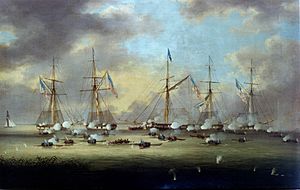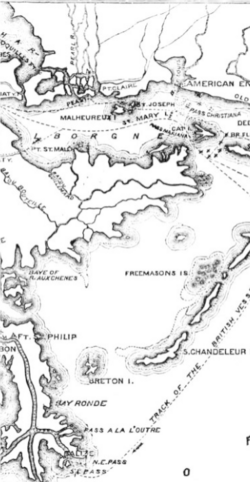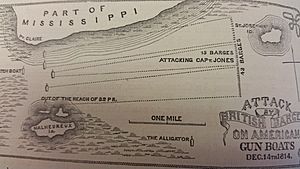Battle of Lake Borgne facts for kids
Quick facts for kids Battle of Lake Borgne |
|||||||
|---|---|---|---|---|---|---|---|
| Part of the War of 1812 | |||||||
 British and American Gunboats in Action on Lake Borgne, 14 December 1814, Thomas Lyde Hornbrook |
|||||||
|
|||||||
| Belligerents | |||||||
| Commanders and leaders | |||||||
| Strength | |||||||
| 42 rowboats | 5 gunboats 1 sloop 1 schooner |
||||||
| Casualties and losses | |||||||
| 94 killed and wounded 1 rowboat sunk |
41 killed and wounded 6 boats' crews captured 5 gunboats captured 1 sloop captured 1 schooner scuttled |
||||||
The Battle of Lake Borgne was a naval fight during the War of 1812. It happened on December 14, 1814, on Lake Borgne in Louisiana. The battle was between the British Royal Navy and the United States Navy.
The British won this battle. This victory allowed them to land their soldiers easily. Nine days later, they launched an attack on New Orleans.
Contents
Why the Battle Happened
British Plans for New Orleans
In 1814, the British wanted to attack New Orleans. They believed this would make the Americans want to end the War of 1812 faster. They also wanted to control the entrance to the Mississippi River. This was important for trade and power.
About 8,000 British soldiers, led by General Edward Pakenham, arrived in the Gulf Coast. Their goal was to capture New Orleans.
American Preparations
The Americans knew an attack was coming. Commodore Daniel Patterson was warned about the British forces. He sent Lieutenant Thomas ap Catesby Jones and a small group of boats to watch for the British.
Jones's group had five small warships called gunboats. They also had a schooner (a type of sailing ship) named USS Sea Horse and a sloop called USS Alligator. The gunboats were armed with cannons.
British Forces Gather
Vice Admiral Sir Alexander Cochrane was the British commander. He ordered his ships to gather near Ship Island (Mississippi). This location was about 60 miles from where the British soldiers would land.
On December 8, British ships reported that American gunboats had fired at them. They realized they needed to destroy these American gunboats first. The gunboats were in the shallow waters of Lake Borgne.
The British Fleet of Rowboats
Admiral Cochrane put Commander Nicholas Lockyer in charge of a special force. This force was made up of 42 rowboats from the British fleet. These rowboats were armed with cannons. They also had about 980 sailors and Royal Marines.
The rowboats could go into the shallow waters where larger warships could not. Their mission was to find and destroy the American gunboats.
American Retreat and First Contact
Lieutenant Jones's American boats moved back towards the Rigolets, a waterway near New Orleans. They were trying to find a good place to defend. On December 13, Jones saw the British rowboats. He realized they were coming to attack his gunboats.
The shallow water made it hard for Jones's boats to move. But the rising tide helped them get into position.
The first clash happened on December 13. The schooner Sea Horse was sent to destroy American supplies at Bay St. Louis. This was to stop the British from capturing them. The Sea Horse fought off British rowboats. But facing too many British boats, the Americans sank the Sea Horse themselves. They also set the supply dump on fire.
The Battle Begins
After rowing for many hours, the British rowboats reached the American gunboats. The American boats were lined up to block a narrow channel. At daybreak on December 14, Jones saw the British rowboats about nine miles away.
As the British advanced, they quickly captured the American sloop Alligator. This happened at 9:30 AM. By 10:00 AM, the British boats were close enough to attack. Commander Lockyer organized his boats into three groups.
The main battle started at 10:39 AM. The British rowed against a strong current. The American gunboats fired cannons at them. Many British sailors were killed or wounded, including men in Lockyer's own boat.
Hand-to-Hand Combat
Eventually, the British boats got close enough. British sailors and marines began to board the American vessels. At 11:50 AM, Commander Lockyer boarded Gunboat No. 156, which was Jones's ship. Both Lockyer and Jones were badly wounded in the fighting.
One British rowboat was sunk during the boarding. But the British kept fighting. By 12:10 PM, the British captured Gunboat No. 156. They quickly turned its cannons against the other American ships. One by one, the British captured all five American gunboats. The battle ended at 12:30 PM.
Aftermath
The battle lasted about two hours. The actual hand-to-hand fighting was much shorter. The British had more men, but the American gunboats were in a strong defensive position. However, two of the American gunboats had drifted out of line, making them easier to attack.
Losses and Captures
The Americans lost all five of their gunboats and their crews. Forty-one American sailors were killed or wounded. Lieutenant Jones became a prisoner of war. He was later honored for his bravery.
The British had 94 killed or wounded. They captured all six American vessels. This included 16 cannons and other weapons. The British commander, Admiral Cochrane, said the captured American boats were as valuable as a large warship. Commander Lockyer was promoted for his success.
The British put the captured gunboats into their own navy. They renamed them Ambush, Firebrand, Destruction, Harlequin, and Eagle.
Impact on New Orleans
The loss of the gunboats meant the British could land their troops without any problems. When people in New Orleans heard about the battle, some panicked. General Andrew Jackson declared martial law in the city. This meant the military took control to keep order.
The American loss also meant Jackson had no way to watch the British movements. However, the captured American sailors were able to trick the British. They gave false information about how many soldiers Jackson had. This made the British think Jackson's forces were stronger than they were.
Later Developments
After the war ended, the American prisoners were sent home. The coastal defenses in Louisiana were improved. New forts, like Fort Pike, were built to protect the area.
In the 19th century, this event was often called an "action" rather than a "battle." But in more recent times, it has become known as the "Battle of Lake Borgne."
Medal for Bravery
In 1847, the British Admiralty created the Naval General Service Medal (1847). This medal was given for various naval actions. The Battle of Lake Borgne was considered a very important boat action. A special clasp, or bar, was added to the medal that said "14 Dec. Boat Service 1814". This was given to the British sailors who fought in the battle. About 205 survivors received this clasp.



